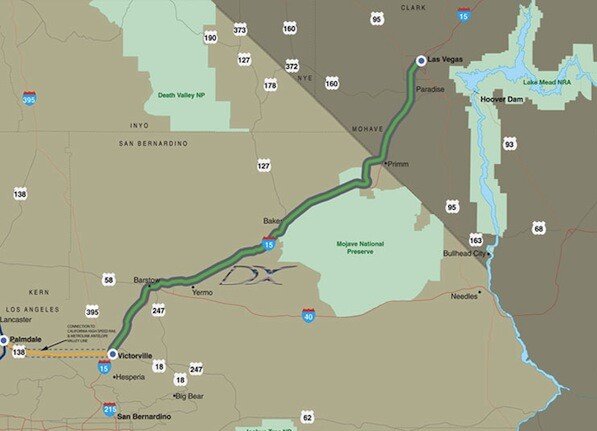Desert High-Speed Rail Stays On Track: Groundbreaking Could be in a Year

The high-speed rail that will carry passengers back and forth from the city of bling to the California high desert passed a major Federal junction.
The Federal Railroad Administration released its final environmental report on the Las Vegas to Victorville route Friday, placing the proposed $6 billion DesertXpress one step closer to breaking ground.
U.S. Senator Harry Reid of Nevada and U.S. Department of Transportation Secretary Ray LaHood reintroduced the project, and the 30,000 construction jobs it would create (mostly in Nevada's Clark County), plus the high profile reality it gives to President Obama's high-speed rail initiatives.

"In a time of enormous economic challenges it will create quality jobs, good paying jobs," said Lahood at a press conference held at UNLV. "This is the same promise that high-speed rail holds for communities across America. And we're starting right here in Las Vegas."
The passenger-only rail system will travel speeds reaching 150 miles per hour on a new grade-separated dedicated double track along I-15. The trip from strip-to-station will take 80 to 85 minutes.
The announcement may also heat up regional lobbying for the Las Vegas station, a location not yet selected. Victorville will be the site for the California station. A future westward link would extend the route to Palmdale, connecting it to California's planned high-speed rail project.
Not cooling down are the Southern California cities that will be bypassed by the route. Opposing the DesertXpress is the city of Barstow, located 34 miles north of Victorville.
According to an economic study commissioned by the city, traffic traveling to and from Las Vegas through Barstow will decrease by up to 33 percent resulting in the loss of 2,295 jobs once the train is running, and that Barstow Councilman Tim Silva is still committed stop the train's progress, reports the Desert Dispatch.
The 6-year project has been privately funded, said DesertXpress CEO Andrew Mack after the conference, before confirming they applied for federal loans up to $4.9 billion through the Railroad Rehabilitation & Improvement Financing program, according to the Las Vegas Sun.
On July 2, 2009, LaHood announced the California high-speed rail corridor would extend to Las Vegas, which provided a path to federal funding and loans dedicated for the development of railroad infrastructure.
It is estimated the project can break ground in two years once Federal Railroad Administration gives final approval.
Taking on the spirit of the trip from Las Vegas to Victorville, Sen. Reid cut the estimated 2-year time in half by stating ground breaking could happen as early as a year from now.


